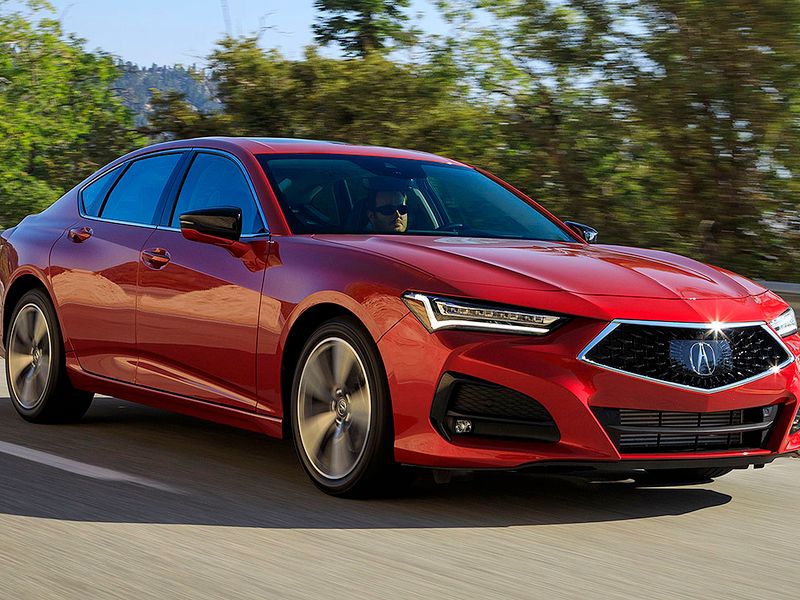
The redesigned 2021 Acura TLX is longer, wider, lower and has a more expansive hood to give it the classic proportions of a sports sedan. It echoes the well-received 2019 Type S Concept that was a thinly veiled precursor to the production sedan. Acura’s Type S performance variant is also being revived on the latest TLX midsize sedan after a decadelong hiatus. Mechanically, the updated model rides on a new platform and suspension architecture with a double-wishbone front suspension, new 10-speed automatic transmission and a four-cylinder turbo motor, which is borrowed from the RDX and makes 272 hp. We’ve gathered some highlights of early TLX reviews from the automotive media.
“The TLX can’t match the nimbleness of the OG Integra, but those new control arms kept the front end just as firmly planted through these bumpy, quick-transition turns. Similarly, there’s no matching the steering feel of the midengine NSX, but aggressive torque vectoring from the SH-AWD rear axle faintly called to mind the mild passive rear steering allowed by the aggressive, tire-consuming rear toe-in on original NSXs. This system can now send 70 percent of available engine torque to the rear — all of which can be sent to one wheel if necessary.”
— Frank Markus, MotorTrend
“The Acura TLX and the TL before it were closely related to the Honda Accord. They shared platforms and powertrains, and buyers were right to say the Acuras were little more than upscale Accords with sport sedan aspirations. That’s no indictment because the Accord has been one of the best mainstream cars on the market for decades, but the TLX now aims to be more than an upscale Accord.
The 2021 Acura TLX splits off from the Accord with its own, exclusive platform and a more sophisticated suspension design. The new body structure boasts 50% more torsional stiffness and it’s almost twice as stiff where the suspension meets the body. The front suspension switches from MacPherson struts to double wishbones, which Acura says provides greater tire contact patch, a lower ride height, and less body lean in turns. The rear suspension continues as an independent multi-link setup.”
— Kirk Bell, Motor Authority
“As good as the new TLX looks, we’ve often been disappointed by similar efforts that don’t deliver on the advertising. That’s not the case here: Acura has done its homework and delivered a proper sports sedan, designed to entertain its driver through an engaging driving experience (when you want it to). The overall sense is one of smoothness, in everything from the power delivery and chassis balance to the ride quality and astonishing quiet in the cabin. Not only does the new TLX no longer look like a warmed-over Honda, it no longer feels like one, either. The improvements to chassis rigidity combine with an improved weight distribution and redesigned double-wishbone front suspension to deliver a buttoned-down, properly premium driving experience, one that feels amazingly cushy in terms of ride quality but still delivers tight responses and proper body roll control.
What’s all that mean? It means that when you want to attack some twisty roads or highway on-ramps at elevated speeds, the TLX responds with eagerness. When you want to just sit back and cruise in serene, relaxed comfort, the TLX does that, too.”
— Aaron Bragman, Cars.com
“Forward momentum is plenty brisk with the full 280 lb-ft coming on at 1,600 rpm. The shorter first gear ratio gets you up and moving in a hurry, and we estimate the 0-60 mph time to be about 5.5-6.0 seconds. It sounds growly and bigger than its 2.0 liters of displacement. That said, Acura does pipe some artificial engine noise into the cabin, and it increases in noise level depending on drive mode.
A 10-speed automatic is the only transmission available. In a vacuum, its shift speed is acceptable, smooth and well-optimized. It’s especially well-tuned to work with you in successive corners in Sport mode, holding onto gears through corners and downshifting on braking. However, its responses are too slow in manual mode and a clear step behind several rivals, including the BMW 3 Series, Audi A4 and Alfa Romeo Giulia. Additionally, Acura won’t let you wring the engine out to the 6,800 rpm redline, automatically shifting up about 300-400 rpm before the tach reaches the red. We ultimately just kept the car in automatic mode. Acura needs to improve this for the Type S, especially considering there is no manual transmission option in the cards.”
— Zac Palmer, Autoblog
“This sedan’s steering reminds me that Acura and Honda have always been capable of mastering this integral bond between car and driver. The TLX’s wheel itself is perfectly sized and its action nicely weighted, with crisp turn-in and plenty of communication about what the tires are up to. Overall, the TLX moves with a lightness reminiscent of the brand’s older, more celebrated products. It’s easy, pleasant and rewarding to drive.
I’ve always liked Acura’s torque-vectoring all-wheel drive and it really helps increase the TLX’s agility on winding roads. Even in the Normal drive setting, the TLX doesn’t mind being hustled through a series of switchbacks in the canyons north of Los Angeles, and if you turn that huge Dynamic Mode knob to the right, you’ll put the TLX in Sport, where the powertrain livens up a bit. (Also, the TLX-going-mega-fast graphic it displays on the infotainment screen is kind of rad, if a bit gimmicky.) Honestly, though, I’d stay out of Sport mode most of the time. The 10-speed automatic can occasionally be dimwitted here, either holding gears too long or not shifting quickly enough, and the steering wheel-mounted paddles don’t offer quick responses.”
— Steven Ewing, Roadshow by CNET